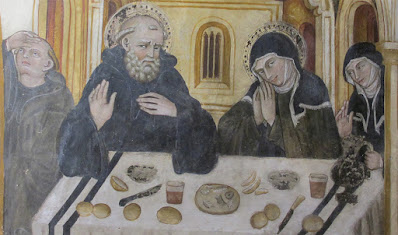Saint Benedict
Benedict's main achievement is his "Rule", containing precepts for his monks. It is heavily influenced by the writings of John Cassian, and shows strong affinity with the Rule of the Master. But it also has a unique spirit of balance, moderation and reasonableness, and this persuaded most religious communities founded throughout the Middle Ages to adopt it. As a result, the Rule of Benedict became one of the most influential religious rules in Western Christendom. For this reason Benedict is often called the founder of western Christian monasticism.
Subiaco
another look at the church
after monks tried to poison St Benedict, he left Subiaco and went to Montecasino where he wrote his Rule and eventually died.
St. Benedict & St. Scholastica |
|
Subiaco-monastery-of-St-Benedict-lower-church-vault-St-Benedict
St. Benedict Cross is considered the symbol of the fight against the Evil.
Certainly the most important element of cult is the Cross of St. Benedict,
especially in its medal's shape.
On one side it introduces,
the image of the Saint Patriarch and on the other side there is a cross,
around which are disposed the Latin initials,
and recite the following prayer:
Crux Sancti Patris Benedicti
Cross of the Saint Father Benedict
Crux Sacra Sit Mihi Lux
Saint Cross be my light
Non Draco Sit Mihi Dux
My leader is not my Demon
Vade Retro Satana
Stand bach, Satan
Numquam Suade Mibi Vana
Don't let myself be tempted by the vanity
Sunt Mala Quae Libas
Evil is your drink
Ipse Venena Bibas
Drink yourself the poison
The initials which are distribuited in the Cross, enclose an invocation to the Saint Cross
in order to be a guide and support against the temptations of Satan,
to whom it is ordered to go away, with the words of Jesus when he was tempted too.
See the end of the article for further explanation.











0 Comments